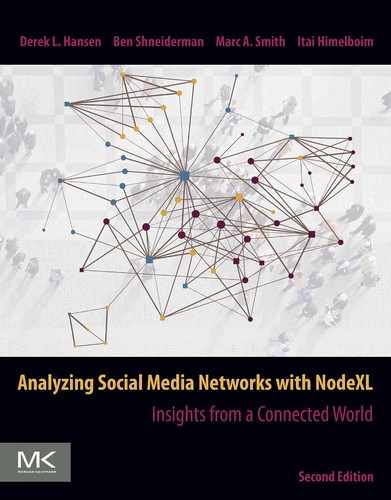Preface
We live in the era of networks. Occasionally the aspirations of academic researchers are in harmony with the needs of software developers, entrepreneurs, and government agency staffers. In our case, the authors brought together complementary backgrounds in information studies, communications, computer science, and sociology, as well as a shared interest in the interdisciplinary topics of human-computer interaction, network analysis, social media, and information visualization. Together, we have worked to build tools that broaden access to insights into complex connected network structures.
Networks are a topic that is gaining interest from the growing community of entrepreneurs who are coping with the success of social media commercial platforms such as Twitter, Facebook, YouTube, and the equally remarkable open source communities that produce valuable resources such as Wikipedia. Social media is now perceived of as a collection of complex networks which can be best understood by drawing on social science methods designed to help identify connections, influencers, and social roles.
Tools for social media network analysis and visualization have been emerging from many research groups and startup companies. These pioneering network analysis tools often require programming skills and knowledge of technical network terminology, making it a challenge for those without programming skills to import and make sense of network data. Today measurements of networks are a mature topic, but research questions remain on the best way to layout and cluster networks with algorithms. Network innovation has expanded dramatically in the past decades, producing breakthroughs that expanded the scale and level of insight into networks that are possible to capture. Similarly, strategies for filtering, visualizing, and decluttering networks have matured as more users tackle a broader variety of problems with increasingly large networks.
The authors have been fortunate to be part of a team with unique skills that continue to develop the NodeXL tool. The project was originally funded by Microsoft Research and for over 10 years it has been sponsored by the Social Media Research Foundation (http://smrfoundation.org), a nonprofit organization dedicated to the development of NodeXL and related tools. The SMR Foundation is focused on supporting scholarship related to social media via tool building and research assistance. Contributors to the foundation are distributed across the United States, Europe, and Asia with links to others around the world. Our members have created plugins and features for extending NodeXL, adding support for language and content analysis, better visualizations, and better reports and presentations.
NodeXL has continued to support the academic community, who have used the tool to publish over 7000 articles citing NodeXL or the first version of this book. Scholars from dozens of disciplines ranging from computer science to communications to digital humanities to history have used NodeXL to tell stories about the networks that underlie our society. They have also found NodeXL to be an invaluable tool in teaching social network analysis to undergraduate and graduate students across the world. Its integration with the familiar Excel spreadsheet program, built-in importers from social media sites, and rich analysis and visualization features make it ideal for those starting to learn social network analysis.
Meanwhile, NodeXL has transitioned from a primarily academic project into a viable commercial tool, as companies have turned to NodeXL to understand how social media users are engaging with their brand, products, and competitors. There have been hundreds of thousands of downloads of NodeXL since its inception. Companies use NodeXL to identify thought leaders in new markets and recognize how they fit into the larger social media landscape. The ongoing success of NodeXL has allowed it to continue developing into an increasingly sophisticated network and content analysis and visualization tool that fills an important niche in the social network analysis landscape.
The future of NodeXL looks bright, with a highly active research and development community that spans the globe, a growing number of users, and an excellent core team of developers. An increasing number of YouTube videos, online tutorials, and supplemental materials are becoming available; though this book is by far the most comprehensive introduction to NodeXL available. Updates continue to be pushed at least monthly, and it is spotlighted at numerous workshops and conference presentations each year. New features and developments are designed to meet the needs of the NodeXL community members and questions or bugs are quickly resolved when uncovered.
The success of NodeXL has validated our initial goal of making social network analysis, especially of social media data, more accessible to the masses. Constant feedback from researchers and practitioners using NodeXL has helped us improve usability, envision new features, and raised our aspirations about what we and our users could accomplish in terms of gaining actionable insights from social media analytics. Although we are pleased with what NodeXL users are able to accomplish, we are humbled by the richness and diversity of social media analytical possibilities. The opportunities and challenges are substantial, which will keep researchers and developers productively engaged for many years to come.
